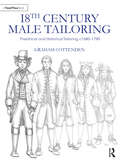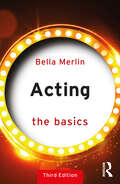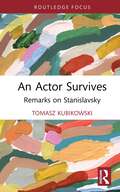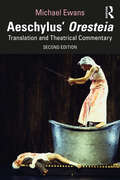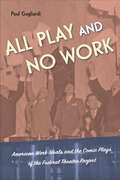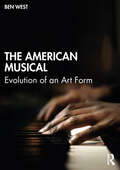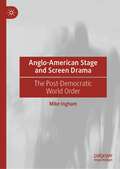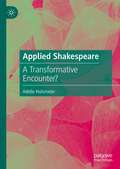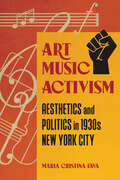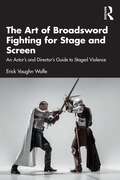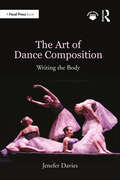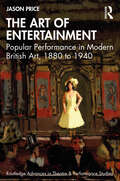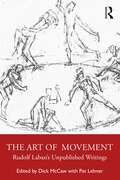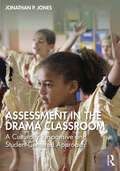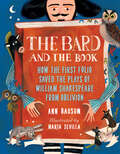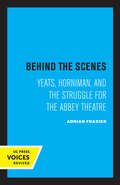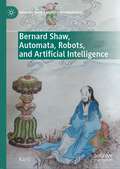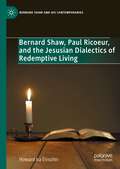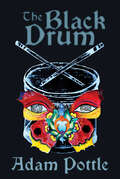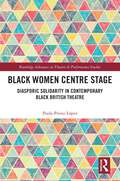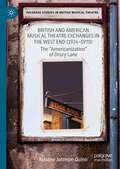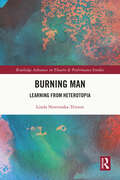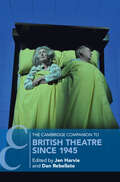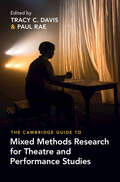- Table View
- List View
18th Century Male Tailoring: Theatrical and Historical Tailoring c1680 – 1790
by Graham Cottenden18th Century Male Tailoring: Theatrical and Historical Tailoring c1680 – 1790 introduces the reader to English eighteenth-century tailoring and covers the drafting of patterns, cutting out in cloth and construction techniques in sequence for the tailoring of waistcoats, breeches and coats. From choosing the right cloth to preparing for the fitting process, this how-to guide will help readers create beautiful, historically accurate eighteenth-century male garments for events and performances. The book contains the following: step-by-step instructions complete with illustrations for students and costumiers who are new to the making of male tailored garments from the eighteenth century; drafting blocks and construction techniques for the different styles through the eighteenth century and patterns, photographs, detailed measurements and articles taken from a variety of male coats, waistcoats and trousers from c1680 – c1790 from museums and collections. 18th Century Male Tailoring is written for costume design and construction students, fashion students and practitioners who have a reasonable working knowledge of sewing and general costume making, but not necessarily of tailoring, drafting patterns, cutting skills and the making of male garments.
Acting: The Basics (The Basics)
by Bella MerlinActing: The Basics 3rd Edition is a dynamic response to recent societal and entertainment industry changes, focusing on inclusion, diversity and equity, and the actor's trajectory from training to rehearsal to performance on stage and screen, with hands-on tools and global perspectives. The book offers vital ways of building a practical acting toolkit, through breath, body, voice, emotions, imagination and spirit. We begin with a socio-cultural look at actor as magician, storyteller, healer and social changer. Throughout, there are insights from Black, Indigenous, First Nations, South/East Asian, intercultural and feminist practitioners, together with methods focusing on disability and accessibility, intimacy directives, mindfulness and intersectionality. Key 'canonical' figures still feature (e.g., Stanislavsky, Meisner, Brecht and Suzuki) with re-visioned perspective. Scattered throughout are post-COVID insights, plus expanded sections on screen acting (including self-tapes) and Shakespeare. This book is useful for beginner or expert, as it's always helpful getting back to basics. Because the author is both an actor and an actor trainer, the tools are steeped in user-friendly application. At the same time, transferable skills (e.g., dynamic listening and empathy) are shown as relevant to everyone. With a glossary of terms and useful online suggestions (including blogs, videos and podcasts), this is ideal for anyone learn anew about the practice and history of acting, or to take their acting and teaching into new terrain.
An Actor Survives: Remarks on Stanislavsky (Routledge Advances in Theatre & Performance Studies)
by Tomasz KubikowskiThis book focuses on the analysis and interpretation of the first volume of the book An Actor’s Work by Konstantin Stanislavsky. This volume is the only part of his planned major work on theatre art that he was able to finish and authorise before his death. Its highly edited variant has long been known as ‘An Actor Prepares’ in the English-speaking world. Tomasz Kubikowski explores Stanislavsky’s material not only as a handbook of acting but also as a philosophical testament of Stanislavsky, in which he attempts to contain his most essential experiences and reflections. This book explores the underlying theme of ‘survival’ in its various meanings, from professional to existential; and the mechanisms and actions we attempt to survive. This study will be of great interest to students and scholars in theatre and performance studies.
Aeschylus' Oresteia: Translation and Theatrical Commentary
by Michael EwansThis is a fully revised new edition of Michael Ewans’ 1995 English translation of the Oresteia, taking into account the extensive work published on the trilogy in recent years.Accompanying this lucid, accurate and actable translation is a substantial introduction, outlining the festival setting of the plays, the original performance conditions and performance style, the form and meaning of the trilogy, the issues surrounding the act of translation, and finally a survey of some major productions since 1980. The text itself is a thoroughly competitive translation into modern English verse, now significantly revised in the light of recent scholarship on the text. It is followed by a theatrical commentary on each scene and chorus, providing unique insights into how the plays might have been staged in ancient Athens and how they can be staged today. The book also includes notes on the translation, two glossaries of names and Greek terms, selected further reading, and a chronology of Aeschylus’ life and times.Aeschylus’ Oresteia: Translation and Theatrical Commentary is the most comprehensive English edition of Aeschylus’ masterpiece, and this new edition fully meets the needs of teachers, students and practitioners working on the trilogy as well as those interested in ancient Greek drama and literature more broadly.
All Play and No Work: American Work Ideals and the Comic Plays of the Federal Theatre Project
by Paul GagliardiMany of the Federal Theatre Project (FTP) plays Paul Gagliardi analyzes in All Play and No Work feature complex portrayals of labor and work relief at a time when access to work was difficult. Gagliardi asks, what does it mean that many plays produced by the FTP celebrated forms of labor like speculation and swindling? All Play and No Work directly contradicts the promoted ideals of work found in American society, culture, and within the broader New Deal itself. Gagliardi shows how comedies of the Great Depression engaged questions of labor, labor history, and labor ethics. He considers the breadth of the FTP’s production history, staging plays including Ah, Wilderness!, Help Yourself, and Mississippi Rainbow. Gagliardi examines backstage comedies, middle-class comedies, comedies of chance, and con-artist comedies that employed diverse casts and crew and contained radical economic and labor ideas. He contextualizes these plays within the ideologically complicated New Deal, showing how programs like the Social Security Act straddled progressive ideals and conservative, capitalist norms. Addressing topics including the politicization of theatrical labor and the real dangers of unchecked economic con artists, the comic plays of the FTP reveal acts of political resistance and inequality that reflected the concerns of their audiences.
The American Musical: Evolution of an Art Form
by Ben WestThe American Musical is a comprehensive history of an American art form. It delivers a detailed and definitive portrait of the American musical’s artistic evolution over the course of seven distinct, newly defined eras, with a unique perspective gleaned from research at more than twenty different archives across the United States.Individual in both its approach and coverage, The American Musical traces the form’s creative journey from its 19th century beginnings, through its 20th century maturation, and to the turn of the 21st century, shedding new light on a myriad of authors, directors, and craftspeople who worked on Broadway and beyond. This book actively addresses the form’s often overlooked female and African-American artists, provides an in-depth accounting of such outside influences as minstrelsy, vaudeville, nightclubs, and burlesque, and explores the dynamic relationship between the form and the consciousness of its country.The American Musical is a fascinating and insightful read for students, artists, and afficionados of the American musical, and anyone with an interest in this singular form of entertainment.
Anglo-American Stage and Screen Drama: The Post-Democratic World Order
by Mike InghamAnglo-American Stage and Screen Drama analyses and discusses the contemporary role of stage and screen drama as a critical forum for progressive thinking in an increasingly polarised geopolitical world. The book addresses the cultural politics of socially engaged 21st century stage plays and films, and makes the case for drama as a sociopolitical forum, in which the complex and contentious issues that confront society can be explored and debated. It conceives of Anglophone political drama as a significant intervention in today’s culture wars, representing the latter as a convenient distraction from the ongoing depredations of neoliberalism. In the main part of the book selected case-study plays and films from each of the first two decades illustrate drama’s capacity to influence critical debate on social justice issues. All of the case-study texts under discussion express a powerful aesthetics of resistance to right-wing ideology, and promote inclusive and enlightened values. This broader orientation underlines drama’s role as a channel for critical agency in today’s putative post-socialist, post-democratic climate.
Applied Shakespeare: A Transformative Encounter?
by Adelle HulsmeierThis book speaks to those interested in where and why Shakespeare’s work is used to capture the transformative intentions of different areas of Applied Theatre practice (Prison, Disability, Therapy), representing a foundational study which considers subsequent histories and potential challenges when engaging with Shakespeare’s work. This is grounded in a case study analysis of three salient British Theatre Companies: The Education Shakespeare Company (prison), the Blue Apple Theatre Company (Disability), and the Combat Veteran Players (therapy).
Art Music Activism: Aesthetics and Politics in 1930s New York City (Music in American Life)
by Maria Cristina FavaSurrounded by the widespread misery of the Depression, left-leaning classical music composers sought a musical language that both engaged the masses and gave voice to their concerns. Maria Cristina Fava explores the rich creative milieu shaped by artists dedicated to using music and theater to advance the promotion, circulation, and acceptance of leftist ideas in 1930s New York City. Despite tensions between aesthetic and pragmatic goals, the people and groups produced works at the center of the decade’s sociopolitical and cultural life. Fava looks at the Composers’ Collective of New York and its work on proletarian music and workers’ songs before turning to the blend of experimentation and vernacular idioms that shaped the political use of music within the American Worker’s Theater Movement. Fava then reveals how composers and theater practitioners from these two groups achieved prominence within endeavors promoted by the Works Project Administration. Fava’s history teases out fascinating details from performances and offstage activity attached to works by composers such as Marc Blitzstein, Charles Seeger, Ruth Crawford Seeger, Elie Siegmeister, and Harold Rome. Endeavors encouraged avant-garde experimentation while nurturing innovations friendly to modernist approaches and an interest in non-western music. Blitzstein’s The Cradle Will Rock offered a memorable example that found popular success, but while the piece achieved its goals, it became so wrapped up in myths surrounding workers’ theater that critics overlooked Blitzstein’s musical ingenuity. Provocative and original, Art Music Activism considers how innovative classical composers of the 1930s balanced creative aims with experimentation, accessible content, and a sociopolitical message to create socially meaningful works.
The Art of Broadsword Fighting for Stage and Screen: An Actor’s and Director’s Guide to Staged Violence
by Erick Vaughn WolfeThe Art of Broadsword Fighting for Stage and Screen provides historical and contemporary techniques and styles for the safe training and use of the European broadsword in a theatrical setting.This book starts with a brief breakdown of the history of broadswords, the time periods associated with their use, and the influences of historical masters and their manuscripts. After the brief history section, this book presents the basic techniques of broadsword fighting, starting with grip and body postures. Readers will then move fluidly into the basic actions of cuts, parries, blocks, and disarms. During this process, actors explore the connection between body and weapon and start learning the elements of storytelling through choreography. Special attention is given throughout the text on techniques which need to be approached in a physically and/or mentally safe way by directors, choreographers, performers, teachers, and students. The final chapter focuses on choreographing a fight and utilizing all the material previously covered in this book, with special notes for actors, directors, and teachers about what makes a good fight, how to keep it safe, and how to create the "wow factor" in choreography.The Art of Broadsword Fighting for Stage and Screen is intended for directors, choreographers, actors, students of acting, martial artists, and enthusiasts of stage combat and historical martial arts.
The Art of Dance Composition: Writing the Body
by Jenefer DaviesThe Art of Dance Composition: Writing the Body is an introduction to modern dance composition, providing clear and structured approaches to designing and defining movement that demystify the creative process.The book introduces the concepts of creating authentic movement, processes for gathering and ordering compositional elements, and the ways in which theme, story, and design relate to bodies moving through space. It approaches the practice of composition from many avenues, including the use of digital tools such as video and video editing software, digital mapping, and motion capture, and through improvisation, sourced gestures, and inspiration from visual art, found objects, and chance methodology. Flowcharts that organize and provide a framework for making dance are included, equipping readers with a clear roadmap for creating their own work.Filled with practical advice, this book is suitable for all aspiring choreographers.The Art of Dance Composition: Writing the Body includes access to performance videos that demonstrate the concepts illustrated in the book. To access the videos, visit www.daviesanddancers.com/links-to-writing-the-body.
The Art of Entertainment: Popular Performance in Modern British Art, 1880 to 1940 (ISSN)
by Jason PriceIn this book, theatre historian Jason Price looks at the relationships and exchanges that took place between high and low cultural forms in Britain from 1880 to 1940, focusing on the ways in which figures from popular entertainments, such as music hall serio-comics, clowns, and circus acrobats, came to feature in modern works of art.Readers with an interest in art, theatre, and the history of modern Britain will find Price’s approach, which sees major works of art used to illuminate the histories of once-famous entertainers and the wider social, political, and cultural landscape of this period, accessible and engaging. The book will bring to life for readers some of the most vivid works of modern British art and reveal how individuals historically overlooked due to their gender, sexuality, or race played a significant role in the shaping of British culture during this period of monumental social change.
The Art of Movement: Rudolf Laban’s Unpublished Writings
by Dick McCawThe Art of Movement: Rudolf Laban’s Unpublished Writings offers new perspectives on the thinking and practice of Rudolf Laban – one of the pioneers of modern European dance and movement analysis. A wealth of Laban’s previously untranslated writings broadens our understanding of his work through new perspectives on his thinking and practice. Alongside these key primary sources, interviews with Laban’s family and colleagues and editorial commentaries shed new light on the significance of his life and career. Laban’s own texts also offer further elaboration of the key themes of his work – eukinetics, choreutics, lay dance, pedagogy and dance notation. This essential companion to The Laban Sourcebook is an ideal resource for any students or scholars of modern dance, dance studies, dance history and movement analysis looking for a deeper understanding of this seminal figure in their field.
Assessment in the Drama Classroom: A Culturally Responsive and Student-Centered Approach
by Jonathan P. JonesThis textbook offers a practical approach for designing and implementing assessment for learning in the drama classroom. Assessment in the Drama Classroom begins with a theoretical overview that covers the purpose of assessment with student-centered, culturally responsive methods. The following chapters present an in-depth analysis of how to organize drama curriculum, develop measurable learning objectives, and implement a backward planning approach to summative assessment. Models and tools for generating diagnostic, formative, and summative assessments for various grade levels invite the reader to adapt these approaches to their classrooms. Ideal for drama education and pedagogy courses, this book is an accessible tool for drama educators to engage in critical reflection on assessment. Drama educators will find methods and suggestions for reimagining their assessment practices and be empowered to meet the learning needs of their students.
Assessment in the Drama Classroom: A Culturally Responsive and Student-Centered Approach
by Jonathan P. JonesThis textbook offers a practical approach for designing and implementing assessment for learning in the drama classroom.Assessment in the Drama Classroom begins with a theoretical overview that covers the purpose of assessment with student-centered, culturally responsive methods. The following chapters present an in-depth analysis of how to organize drama curriculum, develop measurable learning objectives, and implement a backward planning approach to summative assessment. Models and tools for generating diagnostic, formative, and summative assessments for various grade levels invite the reader to adapt these approaches to their classrooms.Ideal for drama education and pedagogy courses, this book is an accessible tool for drama educators to engage in critical reflection on assessment. Drama educators will find methods and suggestions for reimagining their assessment practices and be empowered to meet the learning needs of their students.
The Bard and the Book: How the First Folio Saved the Plays of William Shakespeare from Oblivion
by Ann BausumThe unlikely true story of why we know the name William Shakespeare today, and the four-hundred-year-old book that made it possible.Four hundred years ago, no one bothered to write down the exact words of stage plays. Characters&’ lines were scribbled on small rolls of paper (as in, an actor&’s role) and passed around, but no master script was saved for the future. The main reason we&’ve heard of Romeo, Juliet, Hamlet, and Shakespeare himself is that a group of people made the excellent choice to preserve the plays after the Bard died. If they hadn&’t created the book known as the First Folio, Shakespeare and his works would surely have been lost to history. Part literary scavenger hunt (the search for every existing First Folio continues today), part book trivia treasure trove, and part love letter to Shakespeare, this behind-the-scenes, sharply funny true story is an ideal introduction to the Bard and his famous plays.
Behind the Scenes: Yeats, Horniman, and the Struggle for the Abbey Theatre (The New Historicism: Studies in Cultural Poetics #11)
by Adrian FrazierBehind the Scenes presents the story of Dublin's famous Abbey Theatre and its major creative personalities: W. B. Yeats, Annie Horniman, J. M. Synge, and Lady Gregory. Part history, part sociology, part biography, Frazier's work recreates the forces that shaped the Abbey stage, forces that involved the spirited participation of actors, audiences, press, and financiers as well as of the famous poet-playwright who was its co-director. His book unfolds an entertaining and suspenseful tale, centered on the undeniably autocratic personality of W.B. Yeats and with the political struggles of Ireland as a backdrop. This title is part of UC Press's Voices Revived program, which commemorates University of California Press's mission to seek out and cultivate the brightest minds and give them voice, reach, and impact. Drawing on a backlist dating to 1893, Voices Revived makes high-quality, peer-reviewed scholarship accessible once again using print-on-demand technology. This title was originally published in 1990.
Bernard Shaw, Automata, Robots, and Artificial Intelligence (Bernard Shaw and His Contemporaries)
by Kay LiThis project is the first to explore how Bernard Shaw intersects constructively with automata, robots and artificial intelligence (AI). Shaw was born in the golden age of the automaton. His Bible on the Life Force and Creative Evolution, Back to Methuselah, was written when Karel and Josef Čapek coined the word “robot.” Shaw’s life ran in parallel with the rise of AI, and the big names in AI were his contemporaries. Moreover, empirical analyses of Shavian texts and images using AI uncovers possibilities for new interpretations, demonstrating how future renditions of his works may make use of these advanced technologies to broaden Shaw’s audience, readership and scholarship.
Bernard Shaw, Paul Ricoeur, and the Jesusian Dialectics of Redemptive Living (Bernard Shaw and His Contemporaries)
by Howard Ira EinsohnThis book explores a heretofore unremarked linkage between Bernard Shaw, the twentieth-century French thinker Paul Ricoeur, and Jesus of Nazareth. The ties that bind them are a foundational interest in the social teachings of the Nazarene and their use of a shared dialectics with respect to living the kind of compassionate life that holds out the promise in our contemporary world of achieving something approximating universal wellness on a healthy planet at peace with itself. This work argues that the three principal subjects of the study—independently of one another—used the same dialectical method to reach the same dialectically derived conclusion about how humans can live redemptively in a fractured world.
The Black Drum
by Adam PottleHailed as the world’s first Deaf musical—told entirely in American Sign Language and Signed Music—The Black Drum revolves around Joan and her journey to healing after the death of her wife, Karen. Since Karen’s passing, Joan has been unable to share her music with the world, anguish snatching her desire to perform. Joan’s grief pulls her into a bizarre, black-and-white world where her two beautiful tattoos come to life as guides and together they confront a monster called the Minister. But the only way to defeat the Minister and begin to heal is for Joan to embrace her own voice.An epic fantasy about grief and healing, The Black Drum questions the concept of music we are conditioned to believe, suggesting that music is not just something you hear, it is something you see and feel.
Black Women Centre Stage: Diasporic Solidarity in Contemporary Black British Theatre (Routledge Advances in Theatre & Performance Studies)
by Paola Prieto LópezThis book examines the political alliances that are built across the diaspora in contemporary plays written by Black women playwrights in the UK. Through the concept of creative diasporic solidarity, it offers an innovative theoretical approach to examine the ways in which the playwrights respond creatively to the violence and marginalisation of Black communities, especially Black women. This study demonstrates that theatre can act as a productive space for the ethical encounter with the Other (understood in terms of alterity, as someone different from the self) by examining the possibilities of these plays to activate the spectators’ responsibility and solidarity towards different types of violence experienced by Black women, offering alternative modes of relationality. The book engages with a range of contemporary works written by Black women playwrights in the UK, including Mojisola Adebayo, Theresa Ikoko, Diana Nneka Atuona, Gloria Williams, Charlene James, or Yusra Warsama, bringing to the fore a gendered and intersectional approach to the analysis of the texts. This book will be of great interest to students and scholars in contemporary theatre, gender studies and diaspora studies.
British and American Musical Theatre Exchanges in the West End: The “Americanization” of Drury Lane (Palgrave Studies in British Musical Theatre)
by Arianne Johnson QuinnThis monograph centres on the history of musical theatre in a space of cultural significance for British identity, namely the Theatre Royal, Drury Lane, which housed many prominent American productions from 1924-1970. It argues that during this period Drury Lane was the site of cultural exchanges between Britain and the United States that were a direct result of global engagement in two world wars and the evolution of both countries as imperial powers. The critical and public response to works of musical theatre during this period, particularly the American musical, demonstrates the shifting response by the public to global conflict, the rise of an American Empire in the eyes of the British government, and the ongoing cultural debates about the role of Americans in British public life. By considering the status of Drury Lane as a key site of cultural and political exchanges between the United States and Britain, this study allows us to gain a more complete portrait of the musical’s cultural significance in Britain.
Burning Man: Learning from Heterotopia (Routledge Advances in Theatre & Performance Studies)
by Linda Noveroske-TrittenThis book centres on a philosophical analysis of creative acts in the Burning Man Festival and their roles in wider social change. With particular focus on the Ten Principles of Burning Man, Linda Noveroske posits a re-interpretation of common notions of “self” and “other” as they apply to identity, difference, and the ways that these personal impulses ripple outward from changing individuals into changing societies. Such radical re-imagination of ideology can be most powerful when it occurs in spaces of otherness, of heterotopia. This study casts Burning Man as a heterotopia to not only destabilizes what we think we know about visual art, performance, and creative encounters, but also bring these acts into an attitude of immediacy that facilitates previously unimagined behaviour and opens out artistic drive into the unknown. This book would be of value for scholars and practitioners in Performance Studies, Theatre and Dance, Art History, Psychology, Phenomenology, Architecture and Urban Studies.
The Cambridge Companion to British Theatre since 1945 (Cambridge Companions to Theatre and Performance)
by Jen Harvie Dan RebellatoBritish theatre underwent a vast transformation and expansion in the decades after World War II. This Companion explores the historical, political, and social contexts and conditions that not only allowed it to expand but, crucially, shaped it. Resisting a critical tendency to focus on plays alone, the collection expands understanding of British theatre by illuminating contexts such as funding, unionisation, devolution, immigration, and changes to legislation. Divided into four parts, it guides readers through changing attitudes to theatre-making (acting, directing, writing), theatre sectors (West End, subsidised, Fringe), theatre communities (audiences, Black theatre, queer theatre), and theatre's relationship to the state (government, infrastructure, nationhood). Supplemented by a valuable Chronology and Guide to Further Reading, it presents up-to-date approaches informed by critical race theory, queer studies, audience studies, and archival research to demonstrate important new ways of conceptualising post-war British theatre's history, practices and potential futures.
The Cambridge Guide to Mixed Methods Research for Theatre and Performance Studies
by Tracy C. Davis Paul RaeWe often know performance when we see it – but how should we investigate it? And how should we interpret what we find out? This book demonstrates why and how mixed methods research is necessary for investigating and explaining performance and advancing new critical agendas in cultural study. The wide range of aesthetic forms, cultural meanings, and social functions found in theatre and performance globally invites a corresponding variety of research approaches. The essays in this volume model reflective consideration of the means, processes, and choices for conducting performance research that is historical, ethnographic, aesthetic, or computational. An international set of contributors address what is meant by planning or designing a research project, doing research (locating and collecting primary sources or resources), and the ensuing work of interpreting and communicating insights. Providing illuminating and necessary guidance, this volume is an essential resource for scholars and students of theatre, performance, and dance.
